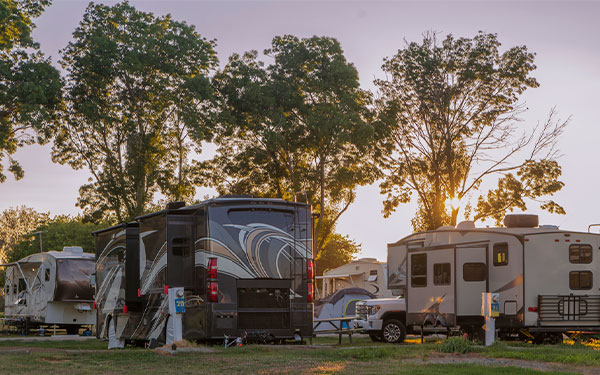According to the RV Industry Association, more than 11 million households across the United States own an RV. If you’re in the market or considering purchasing a motorhome, you may be wondering what the different types of RVs are. RVs come in many shapes and sizes, so no matter what you’re looking for, there’s an RV out there perfect for you. To help you along your search, let’s explore the different types of RVs and who they’re best for.
What Are the Different Types of RVs?
Although there are many differences between RV types, most will fit into one of two categories: towable or motorized.
Towable RVs: Towable RVs are units designed to be towed by another vehicle. Also referred to as trailers, these RVs come in all sizes, including tiny trailers under 2,000 pounds to complete homes on wheels. A benefit of towable trailers is that once at your campsite, you can detach the trailer and use your towing vehicle for outings and errands. The four main types of towable trailers are fifth wheels, toy haulers, travel trailers, and pop-up trailers.
Motorized RVs: As the name suggests, motorized RVs are units with their own engines. Also referred to as motorhomes, these RVs generally contain various living spaces and a cockpit underneath the same roof. Three types of motorized RVs exist: Class A, Class B, and Class C.
What Are the Differences Between Towable RVs?
Fifth Wheels
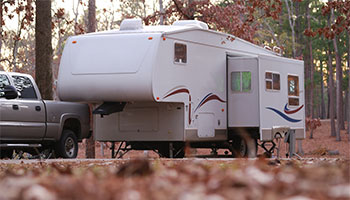
Fifth Wheels are one of the largest types of towable RVs. Due to their size, these trailers are easily distinguishable from others. Perfect for families, these units are typically fully loaded on the inside with all the comforts of a home, such as full-size appliances and living spaces.
Unlike other towable RVs on our list, fifth wheels attach to the back of a pickup truck using a special fifth wheel hitch, which helps with stability when towing.
Fifth Wheel Basics
Size: 25 to 45 feet in length on average
Weight: 8,000 pounds+
Sleeping capacity: 4 to 12 people depending on the layout
Cost: $35,000 to $150,000 depending on the model
Perfect for: families and full-time RVers
Toy Haulers
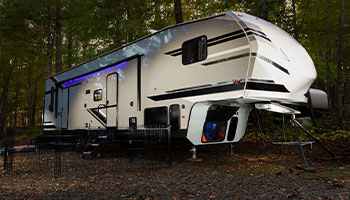
Toy haulers are also large RVs that are towed by another vehicle. However, the main difference between toy haulers and fifth wheels is their interiors. Toy haulers come equipped with an oversized “garage” in the back meant for your toys in addition to living spaces. In this case, toys refer to outdoor vehicles such as snowmobiles, four-wheelers, dirt bikes, etc.
Depending on the model, toy haulers can utilize either a fifth wheel hitch or a bumper pull hitch.
Toy Hauler Basics
Size: 15 to 45 feet in length on average
Weight: 3,000 pounds+ without cargo
Sleeping capacity: 2 to 10 people depending on the layout
Cost: $20,000 to $100,000+ depending on the model
Perfect for: families traveling with large four-wheelers or dirt bikes
Travel Trailers
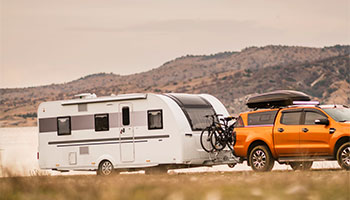
Travel trailers are the most popular type of towable RVs. These trailers utilize a bumper pull hitch and are typically smaller than most fifth wheels and toy haulers. Brands such as Airstream and smaller teardrop trailers are included in this category.
Smaller travel trailers may not come with full-sized appliances, but they do typically have kitchenettes and small bathrooms inside. However, larger travel trailers comparable in size to fifth wheels are available for those looking for additional features.
Travel Trailer Basics
Size: 6 to 40 feet in length on average
Weight: 1,000 pounds+
Sleeping capacity: 1 to 6 people depending on size
Cost: $10,000 to $100,000 depending on the model
Perfect for: solo explorers to small families
Pop-Up Campers and Lightweight Trailers
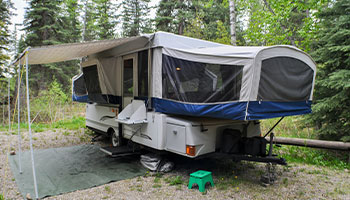
Pop-up campers are one of the least expensive travel trailers you can purchase. As the name suggests, these trailers are designed to “pop up” when parked to provide sleeping space. Pop-up campers are lightweight as their walls are typically made from tent fabric. Because of their size, you don’t need a full-size truck to tow these campers.
These trailers are good starting points if you’re considering joining the RV community but don’t want to commit to a large RV. Due to their design, these often lack features standard in other trailers.
Pop-Up Camper Basics
Size: 5 to 20 feet in length on average
Weight: 1,000 to 4,000 pounds
Sleeping capacity: 1 to 4 people depending on size
Cost: $10,000 to $40,000 depending on the model
Perfect for: solo explorers or traveling couples
What’s the Difference Between Motorized RVs?
Class A RVs
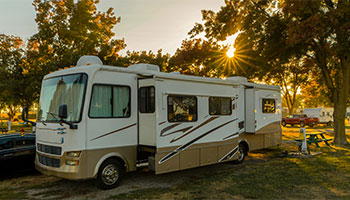
When you think of a classic motorhome, Class A RVs are what typically come to mind. These types of RVs are the largest motorized units available and resemble a coach bus. Spacious enough for families, Class A RVs usually come fully loaded with plenty of appliances, living areas, and storage space.
Due to their size, these RVs aren’t always as fuel-efficient as others and can run on either gas or diesel. To help them get around once at a campsite, many RVers choose to tow a regular vehicle behind their Class A RV.
Class A RV Basics
Size: 25 to 45 feet in length on average
Weight: 12,000 to 30,000 pounds
Sleeping capacity: up to 10 people depending on size
Cost: $50,000 to $200,000+
Perfect for: families or full-time RVers
Class B RVs
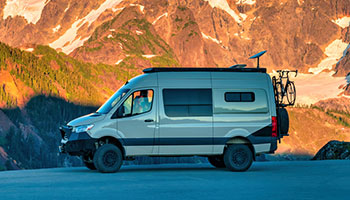
Class B RVs are often referred to as camper vans. Out of all the three types of motorhomes, Class B RVs are the smallest and are built on a van chassis. Since the pandemic, these RVs have become popular amongst travelers who don’t stay in one place for too long.
Although these motorhomes don’t usually have large appliances, they can be custom-built to include whatever you need. Mercedes Sprinters, Ram Promasters, and Ford Transits all fall into this category of RVs.
Class B RV Basics
Size: 20 to 26 feet in length on average
Weight: 6,000+ pounds
Sleeping capacity: 1 to 4 people depending on size
Cost: $40,000 to $100,000+ depending on the build
Perfect for: solo explorers or traveling couples
Class C RVs
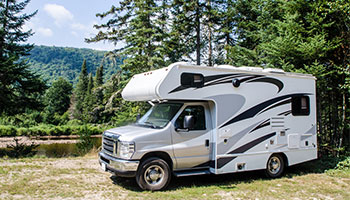
Last but not least on our list is the Class C RV. These motorhomes are a middle ground between Class A and Class B RVs and are typically built on a truck chassis. Class C RVs offer more storage space than camper vans and are easier to maneuver than Class A RVs. The over-cab sleeping area on the front end makes these units easily identifiable.
Due to their extra space, these motorhomes are ideal for smaller families that don’t want to commit to a full-size Class A motorhome.
Class C RV Basics
Size: 20 to 40 feet in length on average
Weight: 10,000 to 20,000 pounds
Sleeping capacity: 1 to 4 people depending on size
Cost: $40,000 to $100,000+ depending on the build
Perfect for: small families or solo explorers
Don’t Forget About RV Insurance
No matter what RV you decide to purchase, carrying specialized RV insurance is essential. Unlike traditional auto policies, RV insurance policies have additional coverages tailored to RVers. At Quick RV Insurance Quotes, our team members specialize in finding you the best combination of coverage and price. To learn more about RV coverages available, contact us at (866) 501-7335. If you’d like to read more about what it’s like to own an RV, visit our RV lifestyle blog section.
The information in this article is obtained from various sources and is offered for educational purposes. Furthermore, it should not replace manuals or instructions provided by the manufacturer or the advice of a qualified professional. No warranty or appropriateness for a specific purpose is expressed or implied.
